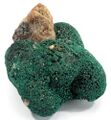Chemistry:Atacamite
| Atacamite | |
|---|---|
 Atacamite from Mt. Gunson mines, South Australia | |
| General | |
| Category | Halide mineral |
| Formula (repeating unit) | Cu2Cl(OH)3 |
| Strunz classification | 3.DA.10a |
| Crystal system | Orthorhombic |
| Crystal class | Dipyramidal (mmm) H-M symbol: (2/m 2/m 2/m) |
| Space group | Pnma |
| Unit cell | a = 6.03, b = 9.12 c = 6.865 [Å]; Z = 4 |
| Identification | |
| Color | Bright green, dark emerald-green to blackish green |
| Crystal habit | Slender prismatic crystals, fibrous, granular to compact, massive |
| Twinning | Contact and penetration with complex twinned groupings |
| Cleavage | Perfect on {010}, fair on {101} |
| Fracture | Conchoidal |
| Tenacity | Brittle |
| Mohs scale hardness | 3–3.5 |
| |re|er}} | Adamantine to vitreous |
| Streak | Apple green |
| Diaphaneity | Transparent to translucent |
| Specific gravity | 3.745–3.776 |
| Optical properties | Biaxial (−) |
| Refractive index | nα = 1.831 nβ = 1.861 nγ = 1.880 |
| Birefringence | δ = 0.049 |
| Pleochroism | X = pale green; Y = yellow-green; Z = grass-green |
| 2V angle | Calculated: 74° |
| Dispersion | r < v, strong |
| References | [1][2][3][4] |
Atacamite is a copper halide mineral: a copper(II) chloride hydroxide with formula Cu2Cl(OH)3. It was first described for deposits in the Atacama Desert of Chile in 1802 by Dmitri de Gallitzin.[1] The Atacama Desert is also the namesake of the mineral.
Occurrence
Atacamite is polymorphous with botallackite, clinoatacamite, and paratacamite.[1] Atacamite is a comparatively rare mineral, formed from primary copper minerals in the oxidation or weathering zone of arid climates. It has also been reported as a volcanic sublimate from fumarole deposits, as sulfide alteration products in black smokers.[2] The mineral has also been found naturally on oxidized copper deposits in Chile, China , Russia , Czech Republic, Arizona, and Australia .[6] It occurs in association with cuprite, brochantite, linarite, caledonite, malachite, chrysocolla and its polymorphs.[2]
Synthetic Occurrence
Atacamite has been discovered in the patina of the Statue of Liberty, and as alteration of ancient bronze and copper artifacts. The mineral has been found as a pigment in sculpture, manuscripts, maps, and frescoes discovered in Eurasia, Russia , and Persia.[6]
Biomineral
Atacamite occurs as a biomineral in the jaws of bloodworms.[7][8]
References
- ↑ Jump up to: 1.0 1.1 1.2 Atacamite on Mindat.org
- ↑ Jump up to: 2.0 2.1 2.2 Handbook of Mineralogy
- ↑ Atacamite on Webmineral
- ↑ Mineralienatlas
- ↑ Warr, L.N. (2021). "IMA–CNMNC approved mineral symbols". Mineralogical Magazine 85 (3): 291–320. doi:10.1180/mgm.2021.43. Bibcode: 2021MinM...85..291W.
- ↑ Jump up to: 6.0 6.1 "Atacamite – CAMEO" (in en). http://cameo.mfa.org/wiki/Atacamite.
- ↑ "High abrasion resistance with sparse mineralization: copper biomineral in worm jaws". Science 298 (5592): 389–92. October 2002. doi:10.1126/science.1075433. PMID 12376695. Bibcode: 2002Sci...298..389L.
- ↑ "Zinc and mechanical prowess in the jaws of Nereis, a marine worm". Proc. Natl. Acad. Sci. U.S.A. 100 (16): 9144–9. August 2003. doi:10.1073/pnas.1632658100. PMID 12886017. Bibcode: 2003PNAS..100.9144L.
External links
 |




